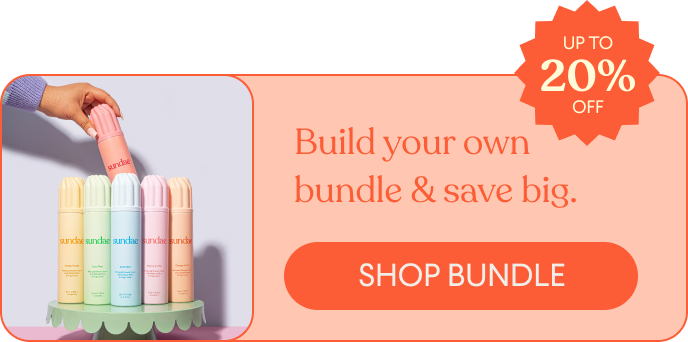Skin Care Ingredients To Avoid While Breastfeeding

For the epi-curious, the pure elation of learning you're going birth a little human is paired with the heartbreak of discovering that you have to forsake sashimi, prosciutto, prosecco, and myriad other delectable foods and beverages to ensure the health of your wee unborn child. But did you know that your daily skincare products impact your baby throughout pregnancy and into your postpartum/breast or chest feeding era?
No need to panic or fret for a second because we've compiled a holy grail cheatsheet into what ingredients you should avoid while feeding your baby (from your own body—badass!)
Pregnancy and parenthood can do a real bender on your skin. Hormones, sleepless nights, and even more sleepless days can mean breakouts, blemishes, and a few more fine lines than you’re used to. The excellent news is that you can still use some of your favourite skincare products while breastfeeding. How come? Well, breastmilk is produced by extracting nutrients from the bloodstream; therefore, only when a skincare product makes it into the bloodstream is it likely to influence breast milk. Hooray!
What Ingredients Should I Avoid In My Skin Care While Breastfeeding?
Hydroquinone
As the chemical that prevents the synthesis of melanin, the pigment responsible for skin color, Hydroquinone can be a lifesaver for new parents experiencing discolouration, vitiligo and melasma. However, because hydroquinone can enter the bloodstream and flow into breastmilk, it's 101% best to avoid.
Retinol
Often craved by nursing parents to lighten dark spots and revitalize dull skin; we are sorry to share that this vibey, much-loved ingredient is strictly forbidden. How come? Retinol is a vitamin that can cause aggravation, inflammation, irritation, and stinging when it comes into contact with your baby's baby-soft skin. Thus, it is simply best to refrain from using retinol on your face and neck when nursing.
Oxybenzone
In order to block UV light, sunscreens often contain the chemical oxybenzone. It can be found in a lot of chemical sunscreens and other skincare items. Despite the fact that there is insufficient research on this component, (why tho???) the majority of them indicate that breastfeeders should avoid using it. Oxybenzone can be absorbed into your breast milk and irritate your infant, resulting in rashes and even hives. Consider switching to a mineral-based sunscreen in order to stay sun-smart and baby-safe.
Parabens
Parabens are synthetic preservatives added to cosmetics and personal care products like skincare goodies. They keep the nasties at bay by preventing the growth of bacteria and fungi. Be careful with products containing parabens as they could be absorbed through the skin and potentially passed onto your little one through breast milk. Parabens are sneaky and can pretend to be estrogen in the body, which can throw off the hormone balance for both you and the baby. While we're not 100% sure about the risks of paraben exposure during breastfeeding, it's better to be safe than sorry and avoid using skincare products with parabens. Let's keep those milk munchkins healthy and happy.
👉 More on body wash ingredients to avoid
Which Ingredients Are Safe?
Ok, after going through all of the things that should not be done, it is time to get to the *fun part* and begin discussing all of the wizz-bang ingredients that are fabulously safe to use to treat the issues that you may be having with your skin.
Vitamin C
Worth the squeeze, and safe for chest-feeding skincare buffs. Due to its capacity to restore the skin barrier, vitamin C is actually a safe and necessary nutrient for post-partem skin and is pivotal for immunity, tissue regeneration, and wound healing.
Niacinamide (Yay!)
All ages, even those who are pregnant or nursing, can use niacinamide because it is so safe and effective. Believe it or not, Niacinamide is actually frequently suggested as a safe and efficient technique to enhance the appearance of the skin by dermatologists worldwide.
AHAs (Alpha Hydroxy Acid)
These compounds are typically derived from fruit and milk and are used in many skincare products for their exfoliating magic. AHAs work by breaking down the bonds between dead skin cells on the surface of the skin, allowing them to be easily removed, revealing fresher, smoother, and more radiant-looking skin. They can also stimulate collagen production and improve skin texture and tone. Some of the most used AHAs in skincare include glycolic acid, lactic acid, citric acid, and malic acid. AHAs are typically found in products such as toners, masks, serums and cleansers (like our Green Tea exfoliating shower foam). It's important to note that AHAs can make the skin more sensitive to the sun, so it's essential to use sunscreen when using products containing AHAs. On the whole, AHAs are A-OK for use during breastfeeding, but to be on the safe side, it's always a good idea to consult with a healthcare professional, such as a dermatologist or obstetrician, before using any skincare products. They can provide personalised advice and recommendations based on your individual needs and circumstances 😊
And finally, the million-dollar question—can I use my beloved Sundae Whipped Shower Foams to spark a little joy while doing the hard yards a feeding a baby. The answer is ABSOLUTELY, Sundae is proudly pregnancy and chest-feeding safe. We recommend treating yourself to our Best Sellers Bundle - with all of our favourites bundled together, you can’t go wrong!
Happy Sundae x
Written By: Lizzie Waley (Sundae Co-Founder & Body Care Enthusiast) | LinkedIn
Fact Checked: Charnnie Frimpong (Sundae Content Marketing Manager) | Linkedin
Our Sources
https://www.verywellfamily.com/a-complete-guide-to-breastfeeding-safe-skincare-5271942
https://asianbeautyessentials.com/blogs/the-idol-beauty-blog/breastfeeding-skincare
https://www.nrdc.org/stories/chemicals-avoid-when-youre-pregnant-or-breastfeeding
https://www.ewg.org/what-are-parabens

